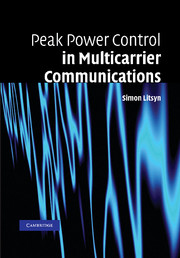Book contents
- Frontmatter
- Contents
- List of figures
- List of abbreviations
- List of notation
- 1 Introduction
- 2 Multicarrier signals
- 3 Basic tools and algorithms
- 4 Discrete and continuous maxima in MC signals
- 5 Statistical distribution of peak power in MC signals
- 6 Coded MC signals
- 7 MC signals with constant PMEPR
- 8 Methods to decrease peak power in MC systems
- Bibliography
- Index
2 - Multicarrier signals
Published online by Cambridge University Press: 03 December 2009
- Frontmatter
- Contents
- List of figures
- List of abbreviations
- List of notation
- 1 Introduction
- 2 Multicarrier signals
- 3 Basic tools and algorithms
- 4 Discrete and continuous maxima in MC signals
- 5 Statistical distribution of peak power in MC signals
- 6 Coded MC signals
- 7 MC signals with constant PMEPR
- 8 Methods to decrease peak power in MC systems
- Bibliography
- Index
Summary
In this chapter, I introduce the main issues we will deal with in the book. In Section 2.1, I describe a multicarrier (MC) communication system. I introduce the main stages that the signals undergo in MC systems and summarize advantages and drawbacks of this technology. Section 2.2 deals with formal definitions of the main notions related to peak power: peak-to-average power ratio, peak-to-mean envelope power ratio, and crest factor. In Section 2.3, I quantify the efficiency of power amplifiers and its dependence on the power of processed MC signals. Section 2.4 introduces nonlinear characteristics of power amplifiers and describes their influence on the performance of communication systems.
Model of multicarrier communication system
The basic concept behind multicarrier (MC) transmission is in dividing the available spectrum into subchannels, assigning a carrier to each of them, and distributing the information stream between subcarriers. Each carrier is modulated separately, and the superposition of the modulated signals is transmitted. Such a scheme has several benefits: if the subcarrier spacing is small enough, each subchannel exhibits a flat frequency response, thus making frequency-domain equalization easier. Each substream has a low bit rate, which means that the symbol has a considerable duration; this makes it less sensitive to impulse noise. When the number of subcarriers increases for properly chosen modulating functions, the spectrum approaches a rectangular shape. The multicarrier scheme shows a good modularity. For instance, the subcarriers exhibiting a disadvantageous signal-to-noise ratio (SNR) can be discarded. Moreover, it is possible to choose the constellation size (bit loading) and energy for each subcarrier, thus approaching the theoretical capacity of the channel.
- Type
- Chapter
- Information
- Peak Power Control in Multicarrier Communications , pp. 3 - 16Publisher: Cambridge University PressPrint publication year: 2007
- 1
- Cited by



